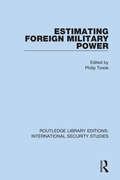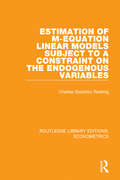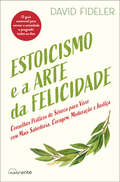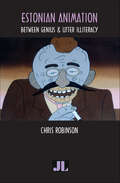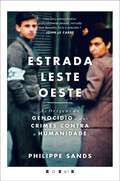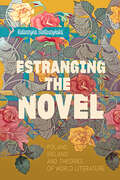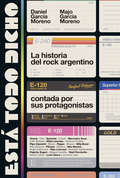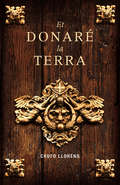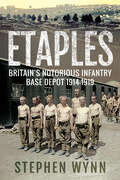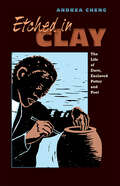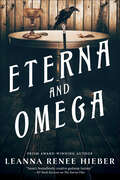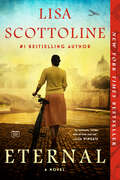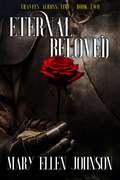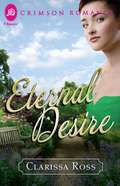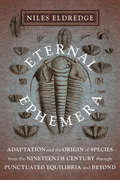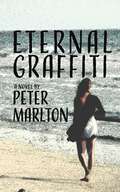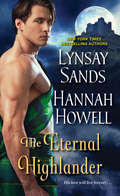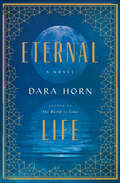- Table View
- List View
Esther: A Novel
by Rebecca KannerFrom the award-winning author of Sinners and the Sea comes a breathtaking new look into the timeless tale of Queen Esther, “a riveting tale of courage” (New York Times bestselling author Tosca Lee).A glittering Persian king has a vast empire that reaches farther than where the sun meets the horizon. He is bathed in riches and commands a frightening military force. He possesses power beyond any other mortal man and rules his kingdom as a god. Anything he desires, he has. Any woman he wants, he possesses. Thousands of them. Young virgins from all across his many lands. A Jewish girl is ripped from her hut by the king’s brutish warriors and forced to march across blistering, scorched earth to the capital city. Trapped for months in the splendid cage of the king’s palace, she must avoid the ire of the king’s concubines and eunuchs all while preparing for her one night with the king. Soon the fated night arrives, and she does everything in her power to captivate the king and become his queen. But wearing the crown brings with it a new set of dangers. When a ruthless man plies the king’s ear with whispers of genocide, it is up to the young queen to prevent the extermination of the Jews. She must find the strength within to violate the king’s law, risk her life, and save her people. This is a story of finding hidden depths of courage within one’s self. Of risking it all to stand up for what is right. This is the story of Queen Esther.
Estimating Foreign Military Power (Routledge Library Editions: International Security Studies #6)
by Philip TowleThis book, first published in 1982, addresses the problem of assessing the central and regional balance of power. The collection of essays by experts on the different countries looks at the miscalculations about the military power of foreign countries which have been made in the past and the difficulties which have to be overcome today before we can reach a correct estimate of the power of other states.
Estimating Illegal Entries at the U.S.-Mexico Border
by Alicia CarriquiryThe U. S. Department of Homeland Security (DHS) is responsible for securing and managing the nation's borders. Over the past decade, DHS has dramatically stepped up its enforcement efforts at the U. S. -Mexico border, increasing the number of U. S. Border patrol (USBP) agents, expanding the deployment of technological assets, and implementing a variety of "consequence programs" intended to deter illegal immigration. During this same period, there has also been a sharp decline in the number of unauthorized migrants apprehended at the border. Trends in total apprehensions do not, however, by themselves speak to the effectiveness of DHS's investments in immigration enforcement. In particular, to evaluate whether heightened enforcement efforts have contributed to reducing the flow of undocumented migrants, it is critical to estimate the number of border-crossing attempts during the same period for which apprehensions data are available. With these issues in mind, DHS charged the National Research Council (NRC) with providing guidance on the use of surveys and other methodologies to estimate the number of unauthorized crossings at the U. S. -Mexico border, preferably by geographic region and on a quarterly basis. Options for Estimating Illegal Entries at the U. S. -Mexico Border focuses on Mexican migrants since Mexican nationals account for the vast majority (around 90 percent) of attempted unauthorized border crossings across the U. S. -Mexico border.
Estimation of M-equation Linear Models Subject to a Constraint on the Endogenous Variables (Routledge Library Editions: Econometrics #13)
by Charles Stockton RoehrigOriginally published in 1984. This book brings together a reasonably complete set of results regarding the use of Constraint Item estimation procedures under the assumption of accurate specification. The analysis covers the case of all explanatory variables being non-stochastic as well as the case of identified simultaneous equations, with error terms known and unknown. Particular emphasis is given to the derivation of criteria for choosing the Constraint Item. Part 1 looks at the best CI estimators and Part 2 examines equation by equation estimation, considering forecasting accuracy.
Estoicismo e a Arte da Felicidade
by David FidelerOs estoicos preocupavam-se intensamente com a pergunta: o que é necessário para viver a melhor vida possível? Se os humanos conseguissem responder a essa pergunta, acreditavam eles, poderiam viver vidas felizes e tranquilas — ainda que o mundo parecesse louco e descontrolado. Isto fez do estoicismo uma filosofia muito prática e também explica o seu reaparecimento atual, pois o nosso tempo — social, político, económico e ambiental — também parece louco e descontrolado.» O estoicismo, a mais influente filosofia do Império Romano, oferece novas formas para desenvolvermos o nosso caráter perante o mundo imprevisível em que vivemos. Amplamente reconhecido como o mais talentoso escritor estoico, Séneca ensina-nos a viver uma vida autêntica e com propósito, a ultrapassar a dor e a transformar a adversidade em oportunidades de crescimento. Esta obra explora as ideias principais do pensamento estoico, demonstrando porque são hoje mais atuais do que nunca. Oito ensinamentos fundamentais - «Viver de acordo com a natureza» para encontrar a felicidade. - A excelência do caráter interior de cada um é o único bem verdadeiro. - Algumas coisas estão inteiramente sob o nosso controlo, enquanto outras não. - Embora não possamos controlar o que nos acontece, podemos controlar a nossa crítica interna e a forma como respondemos aos eventos da vida. - Quando algo negativo sucede, não devemos surpreender-nos, mas ver isso como uma oportunidade para criar uma situação melhor. - A virtude é em si a própria recompensa. É um estado de tranquilidade mental e alegria interior. - A verdadeira filosofia envolve «progredir». - É essencial que nós, enquanto indivíduos, contribuamos para a sociedade. «Este livro é uma joia rara: simultaneamente reconfortante e desafiador, instrutivo e divertido.» Eric Weiner autor bestseller de A Geografia da Felicidade
Estonian Animation: Between Genius & Utter Illiteracy
by Chris RobinsonEver wonder why Estonian animation features so many carrots or why cows often perform pyramids? Well, neither question is answered in Chris Robinson's new book, Estonian Animation. Robinson's frank, humorous, and thoroughly researched book traces the history of Estonia's acclaimed animation scene from early experiments in the 1930s to the creation of puppet (Nukufilm) and cel (Joonisfilm) animation studios during the Soviet era, as well as Estonia's surprising international success during the post-Soviet era. In addition, Robinson writes about the discovery of films by four 1960s animation pioneers who, until the release of this book, had been unknown to most Estonian and international animation historians.
Estrada Leste-Oeste: As Origens do Genocídio e dos Crimes Contra a Humanidade
by Philippe SandsUm livro extraordinário: profundamente pessoal, narrado com devoção, fúria e precisão. «Um livro extraordinário: profundamente pessoal, narrado com devoção, fúria e precisão.» - John Le Carré Numa cidade hoje pouco conhecida, mas que foi um importante centro cultural da Europa de Leste, «a pequena Paris da Ucrânia», a um tempo chamada de Lemberg, Lwów, Lvov ou Lviv, consoante a potência ocupadora, uma estrada percorria-a de leste a oeste. Ao longo dessa estrada, em momentos diferentes, moraram três homens: Leon Buchholz, avô do autor, Hersch Lauterpacht, que viria a cunhar a expressão «crimes contra a humanidade», e Rafael Lemkin, que criaria o conceito de «genocídio», apresentados pela primeira vez nos julgamentos de Nuremberga. Este livro narra a evolução pessoal e intelectual de Lauterpacht e Lemkin, ambos estudantes de Direito na Universidade de Lviv, cada um dos quais considerado o pai do moderno Direito Internacional, ambos presentes em Nuremberga, alheios ao facto de que o homem que julgam - Hans Frank, governador-geral da Polónia ocupada - pode ter sido o responsável pelo assassínio da quase totalidade das suas famílias. Mas este livro é também a memória de uma família, com o autor a traçar a história do seu avô - uma vida envolta em segredos, com muitas perguntas e poucas ou nenhumas respostas - e da sua fuga pela Europa em face das atrocidades nazis. Estrada Leste-Oeste é um livro que mostra que nem tudo foi dito sobre a Segunda Guerra Mundial. Uma meditação sobre a barbárie, a culpa e o desejo de justiça. Raramente se justifica aplicar a qualificação de indispensável a um livro, mas este é esse livro. «Nenhum romance se pode equiparar à realidade.» - Antony Beevor
Estranging the Novel: Poland, Ireland, and Theories of World Literature
by Katarzyna BartoszyńskaTo develop a theory of world literature, this book demands that the theory of the novel can no longer ignore literary forms other than realism.For centuries, the standard account of the development of the novel focused on the rise of realism in English literature. Studies of early novels connected the form to various aspects of British life across the eighteenth and nineteenth centuries, including the burgeoning middle class, the growth of individualism, and the emergence of democracy and the nation-state. But as the push for teaching and learning global literature grows, this narrative is insufficient for studying novel forms outside of a predominately English-speaking British and American realm.In Estranging the Novel, Katarzyna Bartoszyńska explores how the emergence and growth of world literature studies has challenged the centrality of British fiction to theories of the novel's rise. She argues that a historicist approach frequently reinforces the realist paradigm that has cast other traditions as "minor," conceding a normative vision of the novel as it seeks to explain why historical forces produced different forms elsewhere. Recasting the standard narrative by looking at different novelistic literary forms, including the Gothic, travel writing, and queer fiction, Bartoszyńska offers a compelling comparative study of Polish and Irish works published across the long nineteenth century that emphasize fictionality, or the problem of world-building in literature.Reading works by Ignacy Krasicki, Jan Potocki, Narcyza Żmichowska, and Witold Gombrowicz alongside others by Jonathan Swift, Charles Maturin, Oscar Wilde, and Samuel Beckett, Bartoszyńska shows that the history of the novel's rise demands a more capacious and rigorous approach to form as well as a reconceptualization of the relationship between fiction and its cultural contexts. By modeling such a heterogeneous account of the novel form, Estranging the Novel paves the way for a bracing and diverse understanding of the makeup of contemporary world literature and the many texts it encompasses—and a new perspective on the British novel as well.
Está todo dicho: La historia del rock argentino contada por sus protagonistas
by Daniel García Moreno Majo García MorenoLa historia oral y coral definitiva del rock argentino: a través del testimonio de sus grandes protagonistas -de Charly, Fito y Spinetta a Cerati, Prodan, Vicentico, Ciro, Pity, Litto Nebbia, Lebón, Javier Martínez y 70 figuras más-, registrado a lo largo de numerosos programas producidos para la televisión de los años 80 por Daniel y Josi García Moreno, toma forma un relato extraordinario. Pocas personas han hecho tanto por documentar el origen y el devenir del rock rioplatense -una historia que abarca ya más de cinco décadas- como los hermanos Dany y Josi García Moreno. A través de numerosos programas televisivos (Rocanrol, La Cueva, Quizás porqué), y documentales como 30 años de rock nacional, fueron creando un registro audiovisual extraordinario. En las voces de decenas de artistas entrevistados para esas producciones y transcriptas en este libro, hoy toma forma una mirada múltiple y diversa sobre el movimiento y las circunstancias que debió atravesar en un mundo de inestabilidad institucional, prejuicios y grosera censura. Una versión posible de qué es el rock argentino. El relato coral de una historia única. «A lo largo de décadas, Dany y Josi García Moreno y Eduardo Berti grabaron a todos, desde los pioneros hasta las nuevas generaciones. Realizaron reportajes memorables de enorme valor histórico y confesiones increíbles. Si alguien se tomara el trabajo de desgrabar, ordenar y dar forma a ese material, sería un libro formidable. Por suerte, Dany y su sobrina Majo (productora y periodista) se animaron a encararlo. Y este es el resultado».Marcelo Fernández Bitar «Hay algo fascinante en este collage: cada una de las voces habla desde un lugar diferente y desde un tiempo distinto. No solamente este libro no se hizo desde hoy, sino que se hizo desde múltiples pasados, lo que depara una suerte de caleidoscopio móvil (...), una banda sonora documental sobre la banda sonora musical de más de una generación. Una apasionante carambola a dos bandas».Eduardo Berti «Cuando apareció el rock en castellano fue un impacto extraordinario: ¿Cómo? ¿Se puede cantar rock en español?».Javier Martínez «Para nosotros naufragar era quedarnos de bohemia hasta las 8 o 9 de la mañana. Aparecía la gente que se iba a trabajar, que recién se levantaba, y nosotros que no nos habíamos acostado siquiera, éramos los sobrevivientes del naufragio».Litto Nebbia «Esa época, los años 70, era peligrosa y linda. Yo escuchaba la sirena y ya me ponía contra la pared porque pensaba que siempre era para mí. (Pero) nosotros éramos imparables, teníamos una misión».David Lebón «Yo creo en las cosas que transforman y creo que, de alguna manera, con mi música he transformado algunas pautas».Spinetta «Creo que los fans de Los Redondos no tienen la más puta idea de qué hablan las letras. Y así y todo, las cantan y se emocionan. Es el poder del arte».Lito Vitale «(En la música de Charly García) escuchás que la alegría no es solo brasilera por primera vez en la historia argentina. Porque parece que el único pulso vital que ha tenido Argentina ha sido el de la guerra, la sangre, las peleas estéticas y la tragedia. Y en Charly eso aparece como una cosa novedosa... la alegría. Es la idea más importante que veo en Charly y posiblemente en el rock».Fito Páez
Et Cetera, Et Cetera: Notes of a Word-Watcher
by Lewis ThomasA philologist's gold mine! Thomas recounts the history of the usage of words as well as the etymology of English words. The Latin, Greek and Sanskrit roots are accurate. (Note to parents: this book does cover some words which you might not want your youth to read without your supervision.) Index of English words (back of book) provides a fine resource for students. A funny, informative and creative look at words. A fascinating read.
Et donaré la terra
by Chufo LlorénsBarcelona, s.XI. Les aventures d'un jove camperol, recentment arribat a la ciutat per forjar-se un futur. La Barcelona medieval amaga darrere les muralles dues històries, ambdues marcades per l'amor i l'ambició: la d'un camperol que vol canviar el seu destí, amb l'única esperança de prosperar, aconseguir la ciutadania i fer-se així mereixedor de l'amor d'una jove d'alt llinatge, i els amors adúlters del comte de Barcelona, que sumeixen la ciutat en un perillós conflicte polític. Et donaré la terra uneix amb mestria ficció i història per mostrar el vívid fresc d'una ciutat on els pactes, el llinatge, les intrigues de palau, l'ambició comercial i la convivència entre diferents religions es tenyeixen amb les emocions més intenses: passió, amistat, enveja, honor i venjança. Una novel·la apassionant i ambiciosa que submergeix el lector en l'època de la forja d'una ciutat.
Etape: 20 Great Stages from the Modern Tour de France
by Richard MooreWhat if all the best Tour stages happened in one race? In Etape, critically acclaimed author Richard Moore weaves first-person interviews with cycling's great riders to assemble a "dream team" of the best Tour de France stages in modern history. Featuring exclusive interviews with the Tour's legends and scoundrels about their best-ever day on the bike (and their most heartbreaking defeats), Moore unravels lingering mysteries and recounts strange tales from 20 great stages of the Tour: LeMond's impossible return from near-death, Schleck's primal scream atop the Galibier, Merckx's self-described toughest Tour, Cav's mind-bending victory in Aubenas, Hinault's hellish battle with Fignon. Etape assembles the greatest days of modern Tour history into a Tour de France of incredible victory, glorious failure, shocking revelation, and beautiful memories. In the words of those who were there, Etape recreates each day vividly and reveals the beauty and the madness of cycling's greatest race.
Etaples: Britain's Notorious Infantry Base Depot, 1914–1919
by Stephen WynnAn account of the mismanagement and divisive atmosphere of the British Army’s First World War base camp, which led to the infamous Étaples Mutiny.A coastal fishing port situated on the northeast French coast, fifteen miles south of Boulogne, Étaples was a base camp for the British Army, as well as a major medical facility for wounded and sick troops, including both British and Canadian hospitals. Soldiers crossing the Channel on their way to the battlefields of the Western Front found themselves at the Étaples camp, where they would stay an average of two weeks undergoing further training and drills. The training staff who oversaw them had a bad reputation for either their training methods or their lack of genuine military experience at the Front.The Étaples camp was also part of the route taken by men on their way back to the UK. Opportunities for leisure and recreation activities for soldiers away from the camp could be found in Étaples town. Officers, meanwhile, headed to the slightly more up-market beach resort of nearby Le Touquet, which was separated from the Étaples area by the river Canche, and accessible by a bridge. To ensure it remained “just for officers,” pickets, usually members of the Military Police, were placed on the bridge to enforce its exclusiveness.The men’s overall treatment, conditions in the camp and the poor relationship between them and members of the Military Police, was a cocktail for disaster, culminating in a number of incidents in September 1917, which have collectively become known as the Étaples Mutiny, the full story of which can be found in this book.
Etched in Clay: The Life of Dave, Enslaved Potter and Poet
by James ChengThe acclaimed biography-in-verse about the life and times of Dave, an enslaved potter who inscribed his works with short poems during the years leading up to the Civil War.Sometime before 1818, an enslaved young man named Dave was brought to Edgefield, in the heart of South Carolina's pottery-producing area. From the time he was first taught to turn a potter's wheel, Dave showed exceptional natural talent. Soon he was creating pieces of great beauty and often massive size. He also learned to read and write, even though South Carolina had laws prohibiting slave literacy. And then Dave did something even more daring: he began to sign his jars and carve many of them with sayings and short poems that reflected his daily life and experiences. With these courageous acts, Dave quietly protested the brutality of slavery and asserted his humanity. Here is an evocative portrait of Dave as memorable as one of his jars. Through simple yet powerful poetry, including some of Dave's inscriptions, we learn his extraordinary story of perseverance, creative inspiration, and hope. Today Dave's legacy lives on in the artistry of his pottery, in his intriguing words, and as a reminder of the dignity and resilience of the human spirit.
Eterna and Omega (The Eterna Files)
by Leanna Renee HieberLeanna Renee Hieber's gaslamp fantasy series continues and the action ramps up in Eterna and Omega. In New York City, fearing the dangers of the Eterna Compound--supposedly the key to immortality--Clara Templeton buries information vital to its creation. The ghost of her clandestine lover is desperate to tell her she is wrong, but though she is a clairvoyant, she cannot hear him.In London, Harold Spire plans to send his team of assassins, magicians, mediums, and other rogue talents to New York City, in an attempt to obtain Eterna for Her Royal Majesty, Queen Victoria. He stays behind to help Scotland Yard track down a network of body snatchers and occultists, but he'll miss his second-in-command, Rose Everhart, whose gentle exterior masks a steel spine. Rose's skepticism about the supernatural has been shattered since she joined Spire's Omega Branch. Meeting Clara is like looking into a strange mirror: both women are orphans, each is concealing a paranormal ability, and each has a powerful and attractive guardian who has secrets of his own.The hidden occult power that menaces both England and America continues to grow. Far from being dangerous, Eterna may hold the key to humanity's salvation.The Eterna Files seriesThe Eterna FilesEterna and OmegaThe Eterna SolutionAt the Publisher's request, this title is being sold without Digital Rights Management Software (DRM) applied.
Eternal
by Lisa Scottoline#1 bestselling author Lisa Scottoline offers a sweeping and shattering epic of historical fiction fueled by shocking true events, the tale of a love triangle that unfolds in the heart of Rome...in the creeping shadow of fascism. <P><P>What war destroys, only love can heal. <P><P>Elisabetta, Marco, and Sandro grow up as the best of friends despite their differences. Elisabetta is a feisty beauty who dreams of becoming a novelist; Marco the brash and athletic son in a family of professional cyclists; and Sandro a Jewish mathematics prodigy, kind-hearted and thoughtful, the son of a lawyer and a doctor. Their friendship blossoms to love, with both Sandro and Marco hoping to win Elisabetta's heart. But in the autumn of 1937, all of that begins to change as Mussolini asserts his power, aligning Italy's Fascists with Hitler's Nazis and altering the very laws that govern Rome. In time, everything that the three hold dear--their families, their homes, and their connection to one another--is tested in ways they never could have imagined. <P><P>As anti-Semitism takes legal root and World War II erupts, the threesome realizes that Mussolini was only the beginning. The Nazis invade Rome, and with their occupation come new atrocities against the city's Jews, culminating in a final, horrific betrayal. Against this backdrop, the intertwined fates of Elisabetta, Marco, Sandro, and their families will be decided, in a heartbreaking story of both the best and the worst that the world has to offer. <P><P>Unfolding over decades, Eternal is a tale of loyalty and loss, family and food, love and war--all set in one of the world's most beautiful cities at its darkest moment. This moving novel will be forever etched in the hearts and minds of readers. <P><P><b>A New York Times Bestseller</b>
Eternal Beloved (Travels Across Time #2)
by Mary Ellen JohnsonA Jaded Contemporary Romance Novelist Finds Love in 14th Century Ireland in ETERNAL BELOVED, a Historical Time-Travel Romance by Mary Ellen Johnson--14th Century Ireland--Bel Lucy might be the wildly successful owner of Bella Publishing, specializing in romances, steamy and sweet, but she doesn’t believe in love. Bel certainly doesn’t believe in love after a wrong turn in the haunted Castle by the Sea lands her in fourteenth-century Ireland where she is forced to endure the company of the musclebound—not to mention poorly groomed—knight, Alaric DeLaMer.In a time of famine and civil war, Alaric proves to be Bel’s protector while dismissing Bel as a prickly creature who delights in goading him with ridiculous tales. When a duplicitous alchemist sends Bel back to the 21st century, Bel discovers she can never be happy in any time or place—unless its beside Alec, the complete opposite of Bel’s imagined romance heroes.Realizing she was happier in the 14th century, Bel risks everything to battle her way back to Alec but will her eternal beloved be waiting in his Castle by the Sea?Publisher’s Note: Readers passionate about history will appreciate the author’s penchant for detail and accuracy. In keeping with the era, this story contains scenes of brutality which are true to the time and man’s timeless inhumanity. There are a limited number of sexual scenes with some vulgarity characteristic of the time.THE TRAVELS ACROSS TIME SERIESBefore I WakeEternal BelovedTHE KNIGHTS OF ENGLAND, in series orderThe Lion and the LeopardA Knight There WasWithin A Forest DarkA Child Upon The ThroneLords Among the RuinsThe Flames of RebellionMEET MARY ELLEN JOHNSONHer passion for Medieval England sparked Mary Ellen Johnson’s writing career. Her first medieval historical, The Lion and the Leopard, was followed by The Landlord’s Black-Eyed Daughter, a historical novel based on the Alfred Noyes poem, “The Highwayman.” (Published under the pseudonym, Mary Ellen Dennis.) Landlord was chosen as one of the top 100 historical romances of 2013.After taking a twenty-year detour in a quixotic quest to change the world—rather like Arthurian knights’ quests to find the holy grail, which ended in similar failure—Mary Ellen has happily returned to historical fiction writing and her favorite time period, the tumultuous fourteenth century. Her six-book series, Knights of England, follows the fortunes of the characters (and their progeny) introduced in The Lion and the Leopard through the Black Death, the reign of that most gloriously medieval of monarchs, Edward III, the 1381 Peasants’ Revolt, and ends with the deposition and murder of Richard II in 1399.There is nothing Mary Ellen loves more than bringing Medieval England alive for the reader. She particularly enjoys researching battles, campaigns, the daily lives of both lord and peasant, and trying to figure out our ancestors’ thought processes, particularly how they viewed their world. Oh, and did she mention the castles and cathedrals? Mary Ellen likes to say her favorite place in the world is standing before the tomb of the Black Prince in Canterbury Cathedral. (Hyperbole, of course, since Mary Ellen is not that well-traveled and her favorite places are probably wherever her kids and grandkids reside.)
Eternal Desire
by Clarissa RossAs Crimson Romance celebrates its first anniversary, we honor those pioneers who helped shape the direction of romance novels for all of us. Suspense, mystery, paranormal activity and love - always love - have been the cornerstone of the genre since the early 1970s. Now we have updated the covers to these classics - but not the words - and reissued these timeless reads to let you relive the thrill of discovering a world of romance all over again.A captivating, green-eyed heiress, Della Standish had been summoned to Rome to be reunited with her long-lost twin sister, Irma - to share with this beautiful stranger the great family fortune.But from the moment Della entered the opulent halls of the Sanzio Palace, she was encircled by mystery and dark suspicion . . . her life endangered by the satanic power of an Italian noble . . . and her new-found love threatened in a gilt-edged world that hid evil in its secret heart.Sensuality Level: Sensual
Eternal Desire
by Clarissa RossAs Crimson Romance celebrates its first anniversary, we honor those pioneers who helped shape the direction of romance novels for all of us. Suspense, mystery, paranormal activity and love - always love - have been the cornerstone of the genre since the early 1970s. Now we have updated the covers to these classics - but not the words - and reissued these timeless reads to let you relive the thrill of discovering a world of romance all over again.A captivating, green-eyed heiress, Della Standish had been summoned to Rome to be reunited with her long-lost twin sister, Irma - to share with this beautiful stranger the great family fortune.But from the moment Della entered the opulent halls of the Sanzio Palace, she was encircled by mystery and dark suspicion . . . her life endangered by the satanic power of an Italian noble . . . and her new-found love threatened in a gilt-edged world that hid evil in its secret heart.Sensuality Level: Sensual
Eternal Desire
by Clarissa RossAs Crimson Romance celebrates its first anniversary, we honor those pioneers who helped shape the direction of romance novels for all of us. Suspense, mystery, paranormal activity and love - always love - have been the cornerstone of the genre since the early 1970s. Now we have updated the covers to these classics - but not the words - and reissued these timeless reads to let you relive the thrill of discovering a world of romance all over again.A captivating, green-eyed heiress, Della Standish had been summoned to Rome to be reunited with her long-lost twin sister, Irma - to share with this beautiful stranger the great family fortune.But from the moment Della entered the opulent halls of the Sanzio Palace, she was encircled by mystery and dark suspicion . . . her life endangered by the satanic power of an Italian noble . . . and her new-found love threatened in a gilt-edged world that hid evil in its secret heart.Sensuality Level: Sensual
Eternal Ephemera
by Niles EldredgeFrom one of evolutionary biology's major contributors, a compelling work that unravels science's great "Mystery of Mysteries": how new species arise.
Eternal Ephemera: Adaptation and the Origin of Species from the Nineteenth Century Through Punctuated Equilibria and Beyond
by Niles EldredgeAll organisms and species are transitory, yet life endures. The origin, extinction, and evolution of species—interconnected in the web of life as "eternal ephemera"—are the concern of evolutionary biology. In this riveting work, renowned paleontologist Niles Eldredge follows leading thinkers as they have wrestled for more than two hundred years with the eternal skein of life composed of ephemeral beings, revitalizing evolutionary science with their own, more resilient findings.Eldredge begins in France with the naturalist Jean-Baptiste Lamarck, who in 1801 first framed the overarching question about the emergence of new species. The Italian geologist Giambattista Brocchi followed, bringing in geology and paleontology to expand the question. In 1825, at the University of Edinburgh, Robert Grant and Robert Jameson introduced the astounding ideas formulated by Lamarck and Brocchi to a young medical student named Charles Darwin. Who can doubt that Darwin left for his voyage on the Beagle in 1831 filled with thoughts about these daring new explanations for the "transmutation" of species.Eldredge revisits Darwin's early insights into evolution in South America and his later synthesis of knowledge into a theory of the origin of species. He then considers the ideas of more recent evolutionary thinkers, such as George Gaylord Simpson, Ernst Mayr, and Theodosius Dobzhansky, as well as the young and brash Niles Eldredge and Steven Jay Gould, who set science afire with their concept of punctuated equilibria. Filled with insights into evolutionary biology and told with a rich affection for the scientific arena, this book celebrates the organic, vital relationship between scientific thinking and its subjects.
Eternal Graffiti
by Peter Marlton&“I don't know if this is a confession or a purge, a scream or a lullaby,&” begins twenty-seven-year-old Owen Kilroy's journal, in which he writes about the remarkable women—friends and lovers—who've come and gone and who have shaped his life, as well as the many varieties of heartbreak he's experienced. Owen revisits himself as a seventeen-year-old guitar player, songwriter, and drug dealer in a small, fictional California desert town. He relives being arrested, violently, by half the town's police force and sent to juvenile prison. He faces the pain of being disowned by his mother and having his father disappear. And he re-experiences inadvertently killing his girlfriend by providing her with drugs.After escaping from juvenile prison, ending up broke, desperate, and homeless in Venice Beach, he eventually meets Kiera, a nineteen-year-old Irish student at UCLA. She is the great love of his life, a love that he knows would cripple him if he were to lose her. Now, ten years later, Owen discovers that writing about her and all that came before isn't enough. If he is to move on, he realizes he must go back to California and face his ghosts directly.
Eternal Highlander (The MacNachton Vampires #1)
by Hannah Howell Lynsay SandsWriting together for the first time, New York Times bestselling authors Lynsay Sands and Hannah Howell present the darkly passionate story of two men sworn to conquer the hunger that pounds in their blood—and the women who may be their only salvation . . . WHEN DARKNESS FALLS . . . Cathal MacNachton and Connall MacAdie are cousins bound by far more than blood ties and the rugged Highland landscape their clan calls home. The ancient curse of their ancestry has fated them to live by night with an unquenchable thirst that neither can tame. The only thing that can save their souls is marriage to Outsiders—mortals whose untainted blood will weaken the curse in their children and break the chains of fear that have made their clan a breed apart. Bridget Callan and Eva Caxton are the women who will shape the clan&’s destiny. Marriage to these strange and mysterious men will rescue each of them from desperate circumstances—and draw them into a web of danger, desire, and intrigue . . .
Eternal Life: A Novel
by Dara HornA New York Times Notable Book A Booklist Editors’ Choice A Chicago Public Library Best Book of the Year What would it really mean to live forever?Rachel is a woman with a problem: she can’t die. Her recent troubles—widowhood, a failing business, an unemployed middle-aged son—are only the latest in a litany spanning dozens of countries, scores of marriages, and hundreds of children. In the 2,000 years since she made a spiritual bargain to save the life of her first son back in Roman-occupied Jerusalem, she’s tried everything to free herself, and only one other person in the world understands: a man she once loved passionately, who has been stalking her through the centuries, convinced they belong together forever.But as the twenty-first century begins and her children and grandchildren—consumed with immortality in their own ways, from the frontiers of digital currency to genetic engineering—develop new technologies that could change her fate and theirs, Rachel knows she must find a way out.Gripping, hilarious, and profoundly moving, Eternal Life celebrates the bonds between generations, the power of faith, the purpose of death, and the reasons for being alive.

